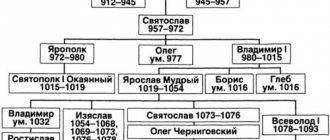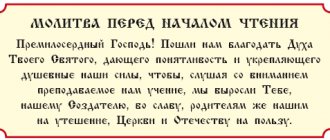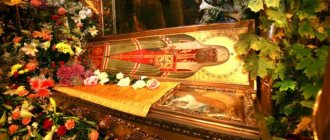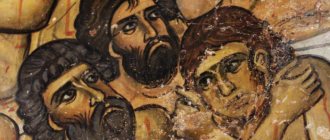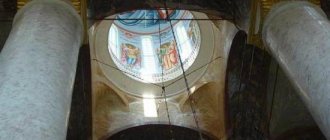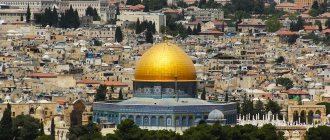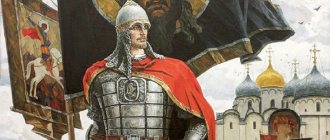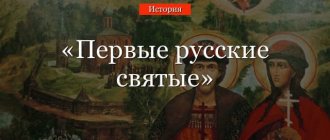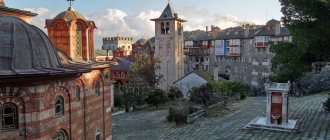In 1015, the great Kiev prince Vladimir Svyatoslavovich died. After his death in Rus', an internecine struggle for power broke out between his sons. Only two people did not participate in it - the Russian princes Boris and Gleb.
The sons of Grand Duke Vladimir, following the example of the great Christian saints and ascetics, called for humility and Christian mercy.
They were vilely killed by their elder brother Svyatopolk, nicknamed “The Damned” for this act. This is how the first Russian saints appeared in the Russian land.
The first Russian saints Boris and Gleb - patrons of the Russian land
The noble princes Boris and Gleb received the names Roman and David at baptism. They are the youngest sons of Grand Duke Vladimir Svyatoslavovich and the Byzantine princess Anna. She belongs to the Macedonian dynasty.
Anna is the only sister of the Byzantine Emperor Vasily II the Bulgarian Slayer and the granddaughter of Emperor Constantine VII Porphyrogenitus.
Holy noble passion-bearing princes Boris and Gleb. Icon. The author is icon painter Viktor Morozov, also known as Izograph Morozov
It is unknown when the holy brothers were born. Historians claim that this happened during the years of the baptism of Rus' by their father.
Grand Duke Vladimir Svyatoslavovich gave them different cities as their inheritance: Boris began to reign in Rostov, and Gleb in Murom. This happened around 987-989.
987 — 989
approximate birth years of brothers Boris and Gleb
The brothers were vilely killed by Svyatopolk, the eldest son of the holy Equal-to-the-Apostles Prince Vladimir, who wanted to seize the Kiev table. The saints, honoring the commandments of God, meekly accepted their fate.
That is why they became the first Russian saints who were canonized as martyrs-passion-bearers by both the Russian and Constantinople Churches.
The Russian Orthodox Church considers them the heavenly patrons of the Russian land.
Veneration of the holy martyrs
The beginning of the veneration of princes in Rus' is associated with three events:
- transferring Gleb's body from the area near Smolensk to the Church of St. Basil, to the grave of his brother;
- initiative of Metropolitan John I of Kyiv;
- a fire in the Church of St. Basil and the transfer of the relics of the brothers to a new church consecrated in their honor.
The princes were canonized before the beginning of the 12th century, since at the end of the 11th century, particles of their relics were already sent to the Czech Republic. Catholics also venerate holy princes. In the Catholic list of saints they are mentioned as Roman the Russian and David the Polish.
Russian miracle workers
In the 12th century, a service to the saints was compiled, the text of which emphasized their power as healers. One Vyshgorod youth suffered from lameness. He prayed at the grave of the holy princes, and they appeared to him in a dream. The miracle workers crossed the young man's leg. In the morning he woke up healed.
Another miracle happened to a one-legged man. His leg was amputated up to the knee. In a vision, holy princes appeared to him walking from the church altar. The man saw them and fell on his face unconscious. People took him to the church, and there they saw how the amputated part of his leg was growing back. Through prayers to the saints a blind man regained his sight. The brothers appeared to him in a dream, crossed their eyes, and he began to see.
The princes punished a worker who did not want to go to church on the feast of St. Nicholas. Two horsemen in white dragged her out of the house by the hand, and the house was destroyed. The worker's hand was paralyzed. She wandered for three years until she came to the Church of the Holy Princes. The woman spent the night near the walls of the temple. Her brothers appeared to her in a dream and gave her a ring. During the morning service the woman was healed.
A miracle happened to an ignorant Varangian at the grave of the princes. He stood on it disrespectfully. Suddenly fire burst out of the ground and burned the Varangian’s legs. The miracle-working brothers helped the elder monk, who was ill in his cell. The elder suffered from abdominal pain, could not get out of bed, but was very thirsty. For several days no one came to see him. The monastery was flooded and the monks were bailing out the water. The elder prayed to Boris and Gleb. Suddenly two monks entered the cell, asked what was wrong with him, and gave him something to drink. The monk asked who they were. The guests called themselves Yaroslav's brothers. When the monks left, the elder realized that the saints had visited him.
Memory in the family of princes
Subsequent rulers came to venerate the relics of the martyrs. Rurik Rostislavovich and Alexander Nevsky won battles thanks to their intercession. During the battle with the Swedes on the Neva, Boris and Gleb appeared in a canoe. In honor of the feat and memory of the saints, the Russian principalities rallied, and the princes fulfilled their obligations to each other. In the name of the brothers, peace was maintained in Rus'.
Things that belonged to the princes were kept as relics. In the church of saints in Vyshgorod there was Boris's sword, but the weapon was taken by Prince Vladimirsky, Andrei Bogolyubsky, the son of Yuri Dolgoruky. In the 12th century the church was destroyed by the Mongols. The relics of those buried under the rubble were not found.
In the princely family, children were often called secular and baptismal names of saints: the sons of Vladimir Monomakh, Yuri Dolgoruky, Andrei Bogolyubsky, Rostislav of Smolensk. The places where the brothers were murdered were honored by the construction of churches - on the Alta and Smyadyn rivers. Later, monastic communities settled there. Temples and monasteries in the name of saints were built throughout Russia. The most famous monasteries are still thriving: Novotorzhsky and Nadozerny Pereslavl-Zalessky monasteries.
Veneration abroad
Other countries also know the holy martyrs:
- Greece - under the names of Roman and David they are mentioned in the collection of lives and teachings “Prologue”;
- Byzantium - in Constantinople they painted icons of saints and built a temple in their honor;
- Armenia - the story of Saints David and Romanos was read in the menaions.
Prayers and the day of remembrance of saints are found in Serbian and Bulgarian prayer books of the 13th-14th centuries. Boris and Gleb were commemorated on July 24, according to the new style - on August 6. Gradually, their holiday began to be celebrated with a solemn service with polyeleos. In the 12th century, special hymns were sung to the brothers. The text of the service was written by Metropolitan John of Kiev. If until the 15th century the name of Svyatopolk was mentioned in the hymns, then in the later stichera by Pachomius Logothetes there is no name of the murderer.
A short biography-life of Boris and Gleb compiled on the basis of ancient Russian chronicles
Only a brief biography of Boris and Gleb is known, while the lives of the saints were compiled on the basis of ancient Russian chronicles.
Researchers recognize “The Tale of Boris and Gleb” as the main source of knowledge about their lives. Scientists claim that it was written by Jacob Chernorizets.
"The Tale of Boris and Gleb." Facial miniatures from the Sylvester collection of the 14th century
Nestor the Chronicler wrote “Readings about Boris and Gleb” in the 1080s
Another version says that the life of Boris and Gleb was compiled on the basis of the “Readings about Boris and Gleb” written by Nestor the Chronicler in the 1080s.
If the “Tale” speaks of miracles performed by the saints, then the Chronicle and “Reading” describe their murder.
From these sources you can get an idea of who the passion-bearers Boris and Gleb were, as well as what they did to honor the commandments of God.
Nestor the Chronicler, the author of “Reading about Boris and Gleb,” says that the holy passion-bearers, the only ones of all the sons of Vladimir, were left with him at an early age.
This happened because of their youth. Apparently, the father was afraid that the young princes would not be able to cope with reigning in their volosts.
Saint Prince Boris knew how to read and write, read the Holy Scriptures and the lives of saints.
Therefore, the brothers’ young years of life were spent under the paternal care of their father.
Moreover, if Saint Gleb was considered a young child, then the eldest of the brothers, Boris, showed outstanding abilities during his life under his father.
He knew literacy, loved to read books, knew the Holy Scriptures.
Boris and Gleb on horseback. Icon of the 14th century. Holy Prince Gleb was influenced by his educated and pious brother Boris. That is why the brothers chose true Christians
Under the influence of his brother, Gleb also received a Christian upbringing. When Boris prayed to the Lord to send him the fate of one of the saints, Gleb listened to him attentively.
Chronicles say that both brothers had a merciful and kind character. They helped and protected the poor, sick and disadvantaged.
main sources
Information about Boris and Gleb, as well as about the development of their veneration, in addition to the chronicles (The Tale of Bygone Years, the Novgorod First Chronicle of the Younger Edition) was preserved in early hagiographic works dedicated to the saints - the anonymous “Tale, and Passion, and Praise of the Holy Martyr Boris and Gleb” (beginning .: “The generation of the righteous shall be blessed, the prophet spoke”) (hereinafter SS), in the closely related “Tale of miracles to the holy passion-bearer of Christ Roman and David” (beginning: “A man cannot speak and not be satisfied with the eye of seeing”) (hereinafter SS ) and in “Reading about the life and destruction of the blessed passion-bearer Boris and Gleb,” written by the hagiographer V. St. Nestor of Pechersk (beginning: “Sovereign Lord, Almighty, Creator of heaven and earth”) (hereinafter referred to as CHN), as well as in early liturgical monuments - the prologue life (beginning: “Martyr Boris grew up from his youth”) and 3 proverb readings ( beginning: “Brothers, help in troubles”; “Hearing Yaroslav, as his father died”, “To your walls, Vyshegorod”). Some details were also reflected in the ancient church chants of Boris and Gleb. The time of origin of the listed works, their sources and complex textual relationships are the subject of ongoing scientific discussions.
The most well-reasoned view at the moment is that the SS arose no later than 1072 (it does not mention the ceremonial transfer of the relics of Boris and Gleb that took place that year), but it is unlikely under Yaroslav the Wise (d. 1054), most likely in Kiev reign of Izyaslav Yaroslavich, in preparation for the celebrations of 1072, Izyaslav was named in baptism in honor of the Great Martyr. Demetrius of Thessaloniki - in the SS Boris and Gleb, as intercessors of the Russian land, are compared with Saint Demetrius of Thessalonica, and Vyshgorod, where the relics of the holy passion-bearers rested, are compared with the “second Selun” [1]. This helps to date the chronicle story. Firstly, it is indisputable that of the two editions in which it was preserved - in the PVL and in the NPL of the younger edition, the latter is closer to the SS, i.e. the edition contained in the previous PVL, the so-called. The initial arch of the 90s. V. Secondly, despite the fact that science has more than once expressed the opinion about the dependence of the chronicle story about the events of 1015–1019. from the much more extensive SS (Metropolitan Macarius (Bulgakov), E.E. Golubinsky, N.N. Ilyin, O. Kralik, A. Poppe), the opposite thesis seems more justified - that the SS was an extended hagiographic reworking of the chronicle story (A I. Sobolevsky, A. A. Shakhmatov, N. I. Serebryansky, S. A. Bugoslavsky, L. Muller, etc.). In the chronicle, in particular, borrowings from the Slavic translation of the Greek chronicle by George Amartol (or rather, “Chronograph according to the Great Exposition”) are more accurately conveyed. Thus, the original chronicle story about Boris and Gleb should be attributed to the Kiev-Pechersk chronicle of the 60s - early 70s. V. Apparently, the story reflected fairly early oral traditions, otherwise it would have been difficult to explain many of them. the details she provides, e.g. the names of the killers Boris (Putsha, Talets, Elovich, Lyashko) and Gleb (Goryaser, cook Torchin). At the same time, there is hardly any doubt that in Vyshgorod, with the beginning of miracles from the relics of the holy passion-bearers, already under Yaroslav the Wise, records began to be kept, which were reflected primarily in the SC and CHN. A hypothesis was also expressed about the existence of something allegedly created already in the 30s. V. hagiography about Boris and Gleb, perhaps in Greek (D.V. Ainalov, Muller).
SF in manuscripts (including in the oldest list as part of the Assumption Collection of the late 12th - early 13th centuries) usually forms a single complex with SS, although it is also found separately from the latter. In terms of prevalence, the SS is much inferior to the SS (according to G. Revelli, 43 lists versus 207), so in most cases the SS was rewritten separately from the SS. Therefore, contrary to this view. Sobolevsky, Shakhmatov, Serebryansky, N.N. Voronin, Muller, we are most likely talking about 2 independent works, united over time in some part of the manuscript tradition. The SCH in its final form took shape during the Kiev reign of Vladimir Vsevolodovich Monomakh (1113–1125), no earlier than 1115, for it contains a story about the transfer of the relics of Boris and Gleb that took place that year, as well as numerous praises addressed to Vladimir. For all that, the midrange is sometimes considered to be complex; Poppe dates its earlier part from the beginning of the Kyiv reign of Svyatoslav Yaroslavich (1073–1076), and S. A. Bugoslavsky - closer to the end. V. (after 1089). T. sp. S.A. Bugoslavsky, who identifies another, intermediate chronological layer in the SC, dating back to around 1108, seems unnecessarily complicated. According to Poppe, the initial part of the SN ended with the 6th miracle (“About the Blind Man”), but the view that the work of Svyatoslav’s time was shorter and ended with a message about the transfer of the relics in 1072, and the miracles from 4- go (“On chrome and dumb”) through 6 were added during the creation of the final edition under Vladimir Monomakh, when it is believed that the text of ChN was used (Muller, A. N. Uzhankov). However, it is possible and even more likely that both SCh and ChN had a common source - the mentioned Vyshgorod records about miracles at the relics of Boris and Gleb. Almost all researchers, following Shakhmatov, date ChN to the 80s. century, apparently closer to the beginning of the decade. Dating of S. A. Bugoslavsky, who considered ChN to be a work of the beginning. XII century, found no support.
The murder of Boris and Gleb is the work of Svyatopolk the Accursed
The murder of princes Boris and Gleb was the work of Svyatopolk the Accursed. This is the generally accepted version of the development of events, which was first put forward in “The Tale of Boris and Gleb.”
The purpose of this crime was power, because Svyatopolk wanted to become the Grand Duke of Kyiv.
Prince Vladimir Svyatoslavovich with his sons. Moscow Kremlin. Faceted Chamber. Fragment of a painting by craftsmen from Palekh
The Grand Duke of Kiev Vladimir Svyatoslavovich died at the age of seventy. By this time, he had eleven relatives and one adopted son. In addition, the prince also had fourteen daughters.
Svyatopolk was the adopted son of the prince. His father didn't love him. The fact is that Svyatopolk’s mother was married to the Grand Duke’s brother Yaropolk.
The chronicle claims that he forcibly removed her from the nunhood, took her as his wife, and she became pregnant by him with Svyatopolk. Already pregnant, Vladimir took her in.
Svyatopolk and Yaroslav (the natural son of Grand Duke Vladimir) were considered the eldest in the family. They pursued their own policies, which the prince did not like.
History has preserved the name of Yaroslav as Yaroslav the Wise. He reigned in Veliky Novgorod, and Svyatopolk in Turov.
Svyatopolk Vladimirovich Damned. Artist V. Sheremetyev. 1867
That is why the Grand Duke imprisoned Svyatopolk together with his wife, the daughter of the Polish prince Boleslav I the Brave. The basis was suspicion of conspiracy.
After the death of Vladimir Svyatoslavovich. Svyatopolk came out of prison and, by right of being the eldest in the family, took the Kiev table.
At the same time, the Grand Duke during his lifetime planned to give power to Boris. The self-proclaimed prince of Kiev began a fierce struggle with his half-brothers, the Vladimirovichs.
The holy passion-bearers princes Boris and Gleb became her victims.
Iconography
The first images of saints were painted by order of Yaroslav the Wise. They were depicted on custom-made reliquary crosses. Later, iconography developed. The brothers were depicted together, in full growth. Princely origin was indicated by fur-trimmed hats, red cloaks and swords. Sometimes saints hold crosses. The basis for writing the images was taken from the description of Boris’s appearance from the legend of the princes:
- high growth;
- round face;
- broad shoulders;
- thin waist.
The prince's cheerful disposition and young age are also mentioned. He died at the age of 25. Since the legend does not describe Gleb’s appearance, the Prince of Murom was portrayed as looking like his brother. Common features are long hair and clean faces without beards. To emphasize the youth of the princes, icon painters used a special technique - they lengthened the figures. The saints seem airy and fragile.
The faces of the saints are turned towards the person praying. On some icons, the brothers are slightly turned towards each other, as if they are talking. Single icons are rare. The lists were made from relief portraits on silver plates covering the shrines containing the relics. In the 14th century hagiographic icons of princes appeared. Icon painters paid special attention to facial expressions. The images are filled with meekness, humility, and kindness. In addition to the figures of princes, they depict miracles performed by them.
According to Byzantine tradition, saints were depicted on horses. The style of iconography spread after the victory over the Mongols in the 12th century. The influence of the images of St. George the Victorious and Demetrius of Thessaloniki can also be traced. They prayed to the saints for intercession in battles and victory over enemies. Therefore, on the icons they took on the warlike appearance of defenders.
A separate type includes icons of saints, on which they are depicted as intercessors of cities. A distinctive feature of the images is Jesus Christ in the cloud segment above the heads of the brothers. Their help is credited with saving Kargopol from fire. An 18th century icon is dedicated to the miracle. On one of her lists, clothes were depicted with cinnabar, as a symbol of the bloody sacrifice of the brothers and Christ.
History says that his father’s squad invited Prince Boris to go to Kyiv, but he refused
Prince Boris enjoyed the love and support of both the squad and the Kyiv people. That is why Vladimir’s squad suggested that he go to war against Svyatopolk and take away the grand-ducal table from him.
“I will not raise my hand against my elder brother: if my father died, then let this one be my father instead,”
- the chronicler quotes Boris as saying.
Murderers at the tent of Prince Boris (above); murder of Prince Boris and Georgy Ugrin (below). Miniature from the Sylvester collection, 2nd half of the 14th century
Because of this, his father’s squad left him. It is possible that she went over to Svyatopolk’s side. Only servants remained to guard Saint Prince Boris.
As the chronicle says: “And then it was the Sabbath day.” The saint spent the night before his death in his tent in solitude and prayer.
July 24
Saint Prince Boris was killed by order of Svyatopolk
Svyatopolk, who promised his brother brotherly love and an increase in his inheritance, decided to kill him and sent the Vyshny Novgorod boyars led by Pushta to him.
On Sunday, July 24, the murderers came to the passion-bearer’s tent. They heard him singing psalms and decided to wait until nightfall. At night they attacked the sleeping prince and pierced him with spears.
The Varangians pierce the heart of Prince Boris with a sword (above); Prince Boris's coffin is being carried for burial (below). Miniature from the Sylvester collection, 2nd half of the 14th century
His Hungarian servant Georgy tried to protect Boris and he was pierced along with him. The saint was still breathing when he was wrapped in a tent cloth and taken to Svyatopolk.
The same, having learned about this, ordered two Varangians to stab his brother with a sword.
Since the people of Kiev were afraid to accept the body of the saint, he was buried in Vyshgorod next to the Church of St. Basil. The holy passion-bearer Prince Boris died a martyr's death at the age of 25.
Death
Boris's squad, which accompanied him on the campaign against the Pechenegs, was ready to march on Kyiv and overthrow Svyatopolk, but the prince refused to shed the blood of his named brother and sent the army home. Svyatopolk doubted Boris’s good intentions and wanted to eliminate his competitor.
The circumstance that pushed the impostor to the bloody massacre was the people’s love for the young prince. Svyatopolk sent loyal servants to Boris, instructing him to kill the heir to the throne. The prince was informed of the intentions of his treacherous brother, but he did not want to preempt the attack or hide.
Murder of Boris
On a Sunday in July, 1015, Boris Vladimirovich was in a tent on the banks of the Alta. He prayed, knowing that death awaited him. When he finished the prayer, he humbly invited the sent killers to do what Svyatopolk had sent them for. Boris's body was pierced by several spears.
The servants wrapped the bloody body of Boris, who was still breathing, and took it as evidence to the prince who ordered the murder. They were met by the Varangians sent by Svyatopolk, sent by the prince to help the murderers. Seeing that Boris was alive, they finished him off with a dagger in the heart. The deceased was taken to Vyshgorod and hidden under the cover of darkness in the Church of St. Basil the Great.
Murder of Gleb
Gleb remained in Murom, and Svyatopolk understood that he could take revenge for the murder of his beloved brother. The killers also went to him, which Gleb was warned about by messengers from Kyiv. But Gleb Vladimirovich, who grieved over his dead father and brutally murdered brother, followed Boris’s example: he did not raise his hand against Svyatopolk and did not start a fratricidal war.
Svyatopolk lured Gleb from Murom, where he could be protected by loyal troops, and sent warriors to him, who carried out a bloody mission at the mouth of the Smyadyn River near Smolensk. Gleb, following the example of his older brother, resigned himself to a terrible fate and, without offering resistance to his tormentors, resignedly accepted death.
The lives of the saints say that Prince Gleb was stabbed to death by his own cook
After the murder of Prince Boris, Svyatopolk decides to deal with Gleb. Researchers believe that he did it out of fear of revenge from his half-brother, Prince Boris. There are two versions of the death of the saint.
One by one, Svyatopolk calls on Gleb, who does not yet know about his father’s death, to urgently come to him in Kyiv. According to another, the passion-bearer was in Kyiv and fled from it to the north, fleeing death.
The assassins are waiting for Prince Gleb (above); murder of Prince Gleb (below). Miniature from the Sylvester collection, 2nd half of the 14th century
In any case, he stops near Smolensk.
If we take the main version of events of Prince Gleb about the death of his father and the murder of his brother Boris, as well as his brother Yaroslav warned about the preparation of an assassination attempt on him from Veliky Novgorod.
September 5
Prince Gleb suffered martyrdom
The killers sent from Svyatopolk arrived to the saint on September 5.
They captured the prince's ship and declared their intention to kill him. The lives of the holy prince indicate that he himself forbade his retinue from using weapons to protect him.
Murder of Gleb on Smyadyn. Miniature. Radzivilov Chronicle. By order of the warrior Svyatopolk the Accursed Goryaser, the cook of the holy prince Gleb Torchin cut off his head
The killers were led by Goryaser, a warrior of the fratricide. He ordered Saint Torchin's cook to kill him. Researchers claim that the traitor came from the Torok tribe.
The body of the murdered man was buried right at the scene of the murder on the banks of the Dnieper. At the same time, the body was placed like a peasant in an ordinary hollowed out log.
After Yaroslav occupied Kyiv in 1019, he ordered the body of the holy prince to be found and buried next to the ashes of Boris at the Church of St. Basil.
Brothers or enemies?
Oddly enough, Boris did not meet the enemy. When he and his squad were returning back, he was overtaken by the sad news of his father’s death. The messengers also brought other news: his elder brother Svyatopolk, against the will of his father, took the princely throne. Before this, in 1013, Svyatopolk, who received the land of Turov (now southern Belarus), entered into an alliance with the Polish king and tried to oppose Kyiv, for which he was imprisoned by Prince Vladimir.
For Prince Boris, the moment of heroism has arrived. His father left a difficult legacy: the memory of the mortal duel between the brothers - Vladimir, then still a pagan, and Yaropolk. Prince Svyatopolk was formally adopted by Prince Vladimir, but in fact was the son of his murdered brother. Will history repeat itself, and the brothers of the next generation will fight tooth and nail?
The day of canonization of the holy passion-bearers Princes Boris and Gleb is unknown
The death of Boris and Gleb caused outrage among the people and Russian princes. At the same time, Svyatopolk paved the way for civil strife, fighting with the remaining contenders for the throne.
The year 1019 is memorable for the fact that Prince Yaroslav, later nicknamed the Wise, defeated the regiments of the fratricide, together with the Pechenegs allied to him, and became the Grand Duke of Kyiv.
B. A. Chorikov. "The Flight of Svyatopolk." XIX century Prince Svyatopolk the Accursed, after his expulsion from Kyiv by Yaroslav the Wise, according to the chronicles, went mad
Svyatopolk fled to Beresten, but died on the way. As the chronicler Nestor says, he suffered paralysis and went crazy. The place of his death is unknown.
Legend claims that he was buried in a deserted place, and a stench emanates from his grave.
After the victory over the fratricide, Prince Yaroslav began to collect information about his brothers. So, by his order, the holy noble prince Gleb was buried next to the body of his brother Boris in Vyshgorod.
Miracles begin to happen at their grave. For example, the Church of St. Basil, next to which the saints are buried, burned down. Church utensils and icons remained intact. This was considered a miracle.
Construction of the Boris and Gleb Church in Vyshgorod and the transfer of the relics of the brothers to the new temple in 1115. Fresco
It is impossible to name the exact date of the canonization of the princes.
The most common version says that this happened during the transfer of the relics of the passion-bearers to the church built for this purpose by order of Yaroslav the Wise.
20 May 1072
on this day the relics were transferred to the church built for this
The ceremony was attended by the children of the Grand Duke of Kyiv, Kiev Archbishop George, and the clergy.
Feat of free suffering
“From that time,” writes the chronicler, “sedition in Rus' died down.” Unfortunately, these words express more a wish than the real state of affairs: the time of internecine wars in Rus' was just beginning. But it is indisputable that the feat of non-resistance of the holy passion-bearers Boris and Gleb made a deep impression not only on the Russian people, but also on the entire Christian world.
Yes, formally they were not martyrs for the faith, because no one demanded that they renounce the Lord, but by taking upon themselves the feat of free suffering, they understood that they were still dying for Christ. And this was a completely new type of holiness. The holy passion-bearers did not accept death as warriors, but it was they who became the heads of the heavenly forces defending the Russian land from enemies. It was they who appeared to Saint Alexander Nevsky on the eve of the Battle of the Ice in 1242 and to Grand Duke Dimitri Donskoy on the day of the Battle of Kulikovo in 1380.
The righteous death of Boris and Gleb made it possible to canonize them as passion-bearers
The Russian Church canonized the holy brothers as passion-bearers. Passion-bearer is one of the ranks of holiness.
He emphasizes a person’s acceptance of martyrdom from fellow believers, and not from enemies of Christianity.
At the same time, only a person who not only accepted torture for fulfilling the Commandments of God, but also did not hold a grudge against his murderers, can be recognized as a passion-bearer. Boris and Gleb did not resist them, so the church calls them passion-bearers.
Holy Truth: The blessed princes Boris and Gleb are the first Russian passion-bearers. Archpriest Andrei Tkachev at 3 minutes 8 seconds he talks about the appearance of the noble princes to his descendant Prince Alexander Nevsky before the Battle of the Neva.
It is also worth noting that the canonization of the saints took place not because they suffered martyrdom, but because their relics were credited with performing miracles.
For example, Prince Vladimir had another son, Svyatoslav. He was also killed by Svyatopolk, but no miracles occurred from his coffin, and he was not canonized.
The holy passion-bearers Princes Boris and Gleb are revered as intercessors of the Russian land. At the same time, they are also revered as healers and miracle workers.
A church built in Vyshgorod in 1115 was dedicated to the pre-Mongol memory of the saints. The relics of saints and other relics were kept here.
The sword of Saint Prince Boris was taken to Vladimir by Andrei Bogolyubsky in 1155
1155
Andrei Bogolyubsky took the sword of Saint Prince Boris to Vladimir
It was destroyed during Batu’s invasion in 1240, and the relics were lost.
They tried to find them several times, but these attempts were unsuccessful.
Some relics, for example, the sword of Prince Boris, were taken to Vladimir by Andrei Bogolyubsky in 1155. From here they went to other Russian cities.
Holy princes Boris and Gleb. Icon. 17th century Moscow. Saints Boris and Gleb in the Russian Orthodox Church are considered an example of sacrifice and the desire not to repay evil for evil, even under the threat of death
The memory of the passion-bearers is honored three times a year
- (2) May 15 marks the day of transferring the relics of the passion-bearers to the tomb;
- (July 24) On August 6, both saints are celebrated;
- (5) On September 18, the name of Saint Gleb is venerated - this is the day of his murder.
Saints Boris and Gleb in the Russian Orthodox Church are considered an example of sacrifice and the desire not to repay evil for evil, even under the threat of death.
Many churches and monasteries are dedicated to the holy princes Boris and Gleb. In addition, cities and villages are named in their honor, for example, Borisoglebsk and Boryspil.
By leaving a comment, you accept the user agreement
They pray to the holy princes:
- About liberation from envy and jealousy.
- About preserving young people in the true faith, about delivering them from temptations, intolerance and anger.
- About the gift of strong faith, which you can rely on in any adversity.
- About taming enmity and anger, about protection from ill-wishers.
- About solving a difficult situation at work, in conflicts with colleagues and superiors.
- About helping those who defend their homeland from enemy attacks, be they military, economic, political or ideological attacks.
- About deliverance from diseases, especially blindness and leg diseases, since there are many testimonies of miraculous healings in front of their icons.
- About spiritual purity and inner harmony.
- About peace in the family, about harmony with relatives and loved ones.
